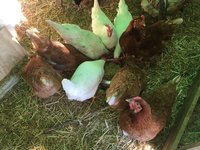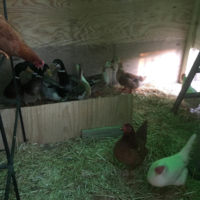TheGreenManFarm
Chirping
- Mar 8, 2018
- 33
- 31
- 54
So I'm a first year poultry owner (in central Maine), although I have experience working with chickens and ducks on farms in the PNW. I've been trained on the deep litter method in the past, and as soon as I started raising my girls this year I went with it. It is now Winter (early and ugly, even by Maine standards), and I have having some serious doubts about continuing with deep litter.
Full disclaimer: My ducks and chickens (7 & 42, respectively) share the same house (10x10x7 sloping down to 5)... It's not as big as I would have liked or planned for, but the local zoning officer turned real problematic about the dimensions & placement of my coop when the town passed an ordinance banning people from keeping chickens within town limits. Although they grandfathered me without making me pay the extra permit fees, they wouldn't let me build the larger coop I designed and I'm moving back to the PNW in the Spring. So please don't think I'm planning on keeping my girls in that space permanently. I got caught by shifting winds and I'm just seeing my girls through the Winter and then moving them along to better pastures, haha.
So now that you're all free to judge me for being less than perfectly prepared, what I'm hoping for is some constructive feedback on using deep litter with mixed flocks in the same house. Specifically:
*I've noticed the ducks generate a LOT more moisture on the floor than chicken-only coops,
*Using deep litter in Zone 4 areas during the Winter vs cleaning it out more often to stay dry,
*The merits of mixing or using more than just straw or hay as bedding in the deep litter
Any additional insights would be appreciated... I've already upped my budget for compressed straw to account for replacing bedding more often than originally planned, and I'm looking for some more experienced feedback on whether to maintain deep litter with more frequent bedding, maintain it with more than just straw/hay, or to dump it and replace their bedding every 3-5 days period.
Thanks!
PS- Included are a few pics giving you an idea what I'm working with.
Full disclaimer: My ducks and chickens (7 & 42, respectively) share the same house (10x10x7 sloping down to 5)... It's not as big as I would have liked or planned for, but the local zoning officer turned real problematic about the dimensions & placement of my coop when the town passed an ordinance banning people from keeping chickens within town limits. Although they grandfathered me without making me pay the extra permit fees, they wouldn't let me build the larger coop I designed and I'm moving back to the PNW in the Spring. So please don't think I'm planning on keeping my girls in that space permanently. I got caught by shifting winds and I'm just seeing my girls through the Winter and then moving them along to better pastures, haha.
So now that you're all free to judge me for being less than perfectly prepared, what I'm hoping for is some constructive feedback on using deep litter with mixed flocks in the same house. Specifically:
*I've noticed the ducks generate a LOT more moisture on the floor than chicken-only coops,
*Using deep litter in Zone 4 areas during the Winter vs cleaning it out more often to stay dry,
*The merits of mixing or using more than just straw or hay as bedding in the deep litter
Any additional insights would be appreciated... I've already upped my budget for compressed straw to account for replacing bedding more often than originally planned, and I'm looking for some more experienced feedback on whether to maintain deep litter with more frequent bedding, maintain it with more than just straw/hay, or to dump it and replace their bedding every 3-5 days period.
Thanks!

PS- Included are a few pics giving you an idea what I'm working with.





